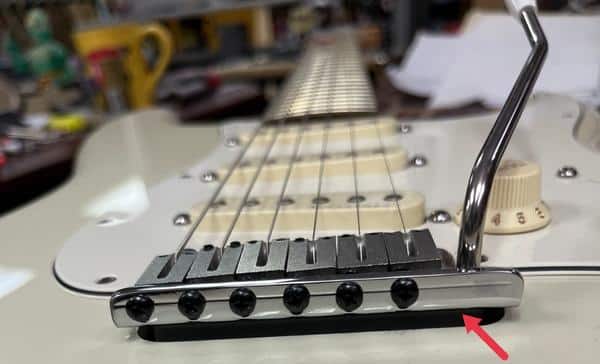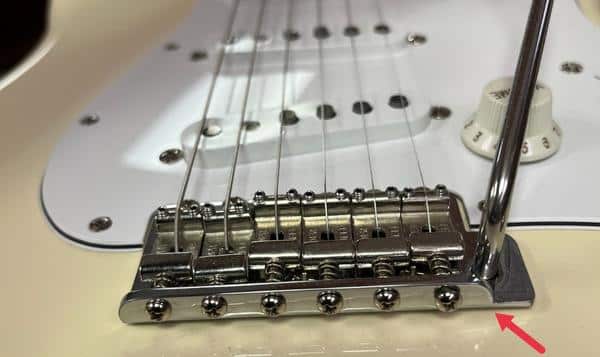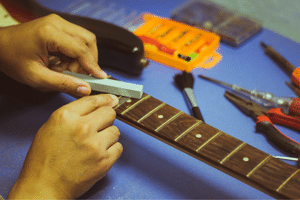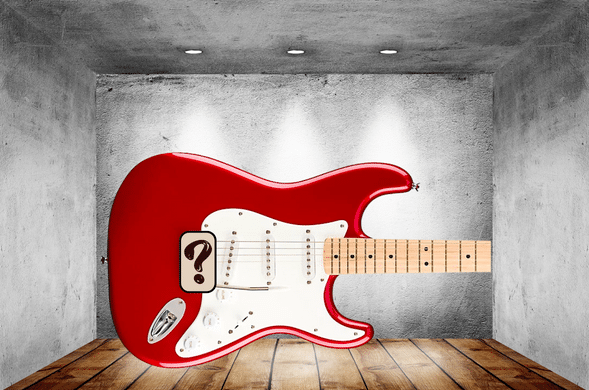Do you understand the differences between a floating vs decked vs blocked tremolo bridge? The answer lies in the way that the bridge is set up to perform.
Keep reading to learn everything you need to know to select the Strat tremolo bridge that works best for you!
You can use the table of contents below to take you to the area that interests you. Click on the little box to open it and then click on the section of the article you want to read, or you can read from start to finish if you want the full tremolo bridge experience!
The Short Answer
A floating bridge moves in both directions, a decked bridge moves in one direction, and a blocked bridge doesn’t move at all. A blocked bridge will give the best tuning stability, while a floating bridge will give the best bridge mobility. The decked bridge can provide a compromise between the other two. Each bridge type affects the guitar’s tone and sustain differently.
Keep On Reading (Below) To Learn More
Floating Vs Decked Vs Blocked Tremolo Bridge: The Basic Differences
How a Stratocaster tremolo bridge is set up determines whether it is floating, decked, or blocked. All two and 6-point Strat tremolos can be set up in these three ways.
A floating bridge can move up and down from its point of rest to raise and lower notes, while a decked bridge lays flat against the guitar’s body and can only be raised to lower notes. A blocked tremolo uses a wooden block to immobilize it.
When the bridge is set up to float or be decked, it is balanced by the tension of the guitar strings in one direction and the opposing tension of the tremolo springs in the opposite direction.
The springs of a blocked tremolo don’t affect bridge movement, but they can still change the guitar’s sound by vibrating in place.
Tremolo Bridge Setup Comparison

Here’s a table that compares the most important ways each Strat tremolo bridge setup affects the rest of the guitar.
To get more info on each tremolo bridge setup, click on the Floating, Decked, and Blocked headings in the table below.
| Comparison | Floating Tremolo | Decked Tremolo | Blocked Tremolo |
|---|---|---|---|
| Tuning Stability | May be problematic | Good to excellent | Best |
| Bridge Movement | Up and down | Up only | No movement |
| Tone & Sustain | Ok | Better | Best |
| If One String Breaks | The other 5 strings go out of tune (sharp) | No change in tuning | No change in tuning |
| Single String (Finger) Bends | Other strings go flat | Other strings may go flat | No change in the other string pitches |
| Drop-Tuning | The other strings go out of tune | Ok | Ok |
| Used By | Jeff Beck, David Gilmour | Jimi Hendrix | Eric Clapton |
Keep On Reading (Below) To Learn More About Each Topic
Floating Tremolo Bridge

(Notice Space Between Bridge And Guitar Body)
This is my favorite way to set up a tremolo bridge on a Strat or strat-body guitar because it gives me the most tonal options when using the whammy bar. I can raise any note’s pitch without having to first lower it by pressing down on the whammy bar of a decked bridge.
Although it’s the most expressive tremolo setup, it can give rise to the most problems, but I feel it’s worth the tradeoff.
Tuning Stability
It’s more challenging to keep a floating tremolo bridge in tune. The higher off the body the bridge floats, the more likely your guitar will go out of tune, especially if you use the whammy bar aggressively.
I have found that using locking tuning machines with a graphite or roller nut is an excellent solution to help keep the guitar in tune. You could also install a locking nut, but they are mostly installed on guitars that have a double-locking tremolo, like the Floyd Rose system.
Bridge Movement
With a floating bridge, you can set the it quite high off the guitar body; to a point. Setting the bridge up too high will take too much downward pressure off the string saddles and can result in string buzzing or movement on the bridge.
I usually set the bridge so that I can bend notes up about 1 to 1 ½ tones, depending on where I am playing on the neck.
I’ve seen players remove the whammy bar but float the bridge a little and use the palm of their hand to press down on it every once in a while.
Tone & Sustain
Setting the bridge too high off the guitar’s body will adversely affect its tone and sustain. The best way to judge this is to play the guitar acoustically (not plugged into an amp). Play notes all over the neck with and without moving the whammy bar in both directions.
String Breakage
The higher you set a floating bridge off the guitar body, the more likely you are to break a high-E or B string when pulling up on the whammy bar, especially with a very light gauge string set.
Worse than that, if you break a string while playing, all your other strings will go out of tune (sharp) in the middle of a song! You could install a bridge lock to help deal with this, but it’s best to have a backup guitar when you play at a gig.
Single String (Finger) Bends
Another challenge of playing a guitar with a floating bridge is doing string bends with your finger(s). If you finger-bend one or more strings, the others are likely to go flat as the bridge rises from the increased string tension.
If you pluck a bent and unbent string, you’ll hear it sound out of tune. The higher you set the floating bridge, the worse this problem can become.
Drop Tuning
You can’t do drop tunings on-the-fly while playing live because you will have to retune all the strings. You’ll need a second guitar with a drop tuning. Another solution is to use a guitar with a Floyd Rose bridge that has a D-Tuna.
Guitar Players That Use A Floating Bridge
In my mind, Jeff Beck is the absolute master of the floating bridge! Eric Clapton has stated that Jeff makes it appear as if he is “pulling the sound.” Beck’s use of the whammy bar to embellish harmonics is absolutely insane!
I also like how David Gilmour uses his bridge to create vibrato. The sound he gets is almost otherworldly.
Yngwie Malmsteen floats his Start bridge just enough to pull strings up about ½ tone. He more or less uses a Fender floating bridge factory-set height setup.
Let’s not forget some of the Floyd Rose floating bridge masters, like Steve Vai, Joe Satriani, and John Petrucci!
Decked Tremolo Bridge

(No Space Between The Bridge And Guitar Body)
My first Strat, back in 1970, came with five springs and a decked tremolo. I didn’t find it too useful, other than for “divebomb” type effects that put the guitar out of tune. It wasn’t long before I removed two springs, filled in the nut slots with graphite from a pencil, and floated the tremolo.
Today, most Fender Strat tremolos are set up at the factory to float a little, especially the 2-point bridges. Still, there are some advantages to having a decked tremolo, especially if you never use the whammy bar.
Tuning Stability
Decked tremolos generally stay in tune better than floating tremolos when not used too aggressively.
If you never use the tremolo, a decked bridge is ideal and will help the guitar stay in tune throughout your gig! These players usually remove the bar as soon as they get the guitar.
Bridge Movement
One disadvantage is that you can’t raise a note with the whammy bar unless you drop it first. So, it sounds more like a pitch drop followed by the note being bent up, or you can push the bar down while muting the strings and then pull up to get the desired effect.
Tone & Sustain
The tone and sustain are generally better than with a floating bridge but not as good as blocking the tremolo plate.
It’s easy to hear the improvement in tone and sustain when going from a floating to a decked Strat, especially if you listen without plugging it in.
String Breakage
It’s doubtful that you will break a string using the whammy bar since you can’t bend it higher than it already is.
The big advantage here is that if one string breaks, unlike the floating bridge, all the other strings stay in tune!
Single String (Finger) Bends
The problem with bending a string(s) with your finger is that if the bridge is not pulled down against the guitar’s body with enough force, it could move up a little and make any unbent strings sound flat.
To prevent this, use five springs and screw the tremolo spring claw right up against the wood of the tremolo cavity.
Drop Tuning
You can lower the pitch of any of the strings without throwing the others out of tune since the tremolo is already down as far as it can go.
Guitar Players That Use A Decked Bridge
Jimi Hendrix was the most famous guitar player ever to use a decked tremolo bridge!
By the early 1980s, most Strat whammy bar users had already changed their decked tremolo to a floating unit to benefit from the extra functionality.
Blocked Tremolo Bridge

(Wood Piece Between Tremolo Block And Body)
If you never use the whammy bar on your Strat, the best approach is to immobilize it so it can’t move in either direction.
The easiest way to do this is to screw the tremolo spring claw flat up against the tremolo cavity and use a block of wood that is thick enough to push the tremolo block forward as much as possible, like in the photo above.
Tuning Stability
A blocked tremolo gives you the best tuning stability, compared to the floating and decked bridges.
Bridge Movement
Only block a tremolo bridge if you never intend to use the whammy bar since it can’t move in either direction!
Tone & Sustain
Blocking a tremolo can improve the tone and sustain even more than a decked bridge. In my opinion, this gives you the best-sounding Strat if you can live without the whammy bar.
String Breakage
String breakage is never due to the bridge since it is immobile. If you’re breaking strings, check the saddles to be your they don’t have sharp edges of spurs.
Single String (Finger) Bends
Doing finger bends or vibrato on one string will not change the pitch of another string. If you do very subtle finger bends or vibrato, you’ll find it easier to do with clarity on a Strat with a blocked tremolo.
Drop Tuning
You can always rely on your Strat to remain in tune when dropping one or more strings with s blocked tremolo.
Why Not A Hardtail Bridge Instead?
So, why not just get a Strat with a hardtail (non-tremolo) bridge? They are still available from the Fender factory.
Part of the iconic sound of a Strat comes from the springs, which give it a more resonant and dimensional sound. If you compare a blocked Strat with five springs against a hardtail Strat, which has no springs, you’ll hear the difference!
I have two blocked and one hardtail Strats. The hardtail Strat sounds more “two-dimensional.” It’s hard to explain but easy to hear. I still like the hardtail sound, but it’s not what you would typically expect from a Strat.
Guitar Players That Use A Blocked Bridge
The most famous guitar player to use a blocked Strat is Eric Clapton. Eric blocks all his Strats and equips them with five springs. He claims that they sound better than hardtail Strats.
All Eric’s Fender signature “Blackie” Strats come blocked from the factory.
Are You Qualified To Make Guitar Adjustments Or Modifications?

It’s great to work on your guitars, especially if you have a lot of them, but you should always be aware of your limitations.
Adjusting things like an electric guitar’s string height (action) or pickup height can be straightforward. Still, some adjustments require the proper training and experience, like adjusting a guitar’s truss rod.
Adjusting the height or angle of your guitar bridge may also require a truss rod adjustment.
When you doubt your ability to adjust, repair, or modify your guitar, it’s always best to bring it to a competent guitar technician or luthier (guitar designer & builder). You can permanently damage your guitar, and it might never play and sound right again!
Making modifications to your guitar can void its manufacturer’s warranty and cause permanent damage to the instrument. Certain modifications are irreversible, so you may be stuck with them, even if you desperately want to restore the guitar to its original condition!
I learned that the hard way over the years until I did a three-year apprenticeship in a guitar repair shop. Now I have my own home workshop with the proper training and equipment to safely maintain and repair all my instruments.
Remember: “When In Doubt, Send It Out!”
Frequently Asked Questions

Here are some of the questions I get asked about Strat tremolo bridges.
If your question does not appear here, please put it in the comments, and I will get right back to you with an answer.
How Do You Intonate A Floating Bridge?
Without touching the whammy bar, hold the guitar in the playing position. Check the tuning of each string with a digital tuner, using the open note and the note at the 12th fret. Repeat the process using the note at the 12th fret and the 12th fret harmonic.
Adjust the position of each string’s bridge saddle accordingly to make the notes on each string in tune.
How Much Should A Strat Bridge Float?
There is no specific bridge height from the guitar’s body, it depends on how much you want to pull the whammy bar up. Typically, Strats come setup from the factory with a floating bridge height of 1/8 to1/4 inch up off the guitar’s body.
I typically set my floating bridge height to 1/4 to 3/8 inch up of the body, and sometimes as high as 1/2 inch. If you go higher than 1/2 inch, you will likely encounter problems with the guitar’s tuning, tone, and sustain.
How Do You Set Up A Strat Tremolo To Stay In Tune?
If your tremolo is floating, check to be sure it is not set too high off the guitar’s body. You may need to lubricate the string saddles. Adjust the tremolo spring claw so that all the springs are the same length The claw should be parallel to the wood that it is screwed into.
If the guitar has two springs, you may need to add a third spring to help keep it in tune. Strats with five springs usually stay in tune best.
Decked tremolos stay in tune better than floating tremolos, while blocked tremolos never cause a guitar to go out of tune.
How Do You Raise The Bridge On A Stratocaster?
On a Strat with a 2-point bridge, raise it by turning the studs that the bridge pivots on counter-clockwise. With a 6-point tremolo, turn the six screws counter-clockwise.
Which Tremolo Bridge Is Best?
Choosing a two vs. a 6-point Strat tremolo bridge depends on your preference and playing style. One bridge is not necessarily better than the other. See 2 Vs 6 Point Tremolo Bridge – The Ultimate Comparison! for more info.
How Many Springs Should A Tremolo Have?
There is no ideal number of springs for a Strat tremolo bridge. It depends on the bridge type (two vs. 6-point), how the bridge is set up (decked vs. floating vs. blocked), and your playing style.
Most Strat players use three springs, but two springs will make the tremolo more responsive, while four or five springs will help to keep it in tune better.
Final Thoughts

I hope this floating vs decked vs blocked tremolo bridge article answered all your questions, but if not, leave me a comment, and we’ll get it straightened out!
There is no “best” choice when it comes to Strat bridge setup. A blocked bridge gives you the best tuning stability and finger string-bending expression, while a floating bridge offers the most whammy bar flexibility. The decked tremolo can give you somewhat of a compromise between the other two bridge setups.
It’s important to find the bridge setup that works best for your playing style.
Each bridge setup has its particular effect on a guitar’s tone and sustain. If you gig with a floating bridge Strat, it’s best to have a backup guitar, in case a string breaks or you perform songs with a drop tuning.
Related Article ➡ Does Vibrato Increase Sustain? Make Your Solo Sound Awesome!
Related Article ➡ Does Your Guitar Affect Vibrato Playing? – Make Solos Soar!

Tell Me What You Think

Please leave a comment below if you enjoyed this article, have any questions about Strat tremolos, or want to give your point of view. I will be happy to help you.
- Which Strat tremolo setup do you prefer? Why?
- Do you have more than one Strat with different tremolo setups?
- Are you using a lubricated or roller nut to help keep your guitar in tune?
- After reading this article, do you feel comfortable trying each setup?
- What else is on your mind?



I agree with you that working on the guitar can look very simple but it’s technical. It requires some level of skill and training. For me, I always prefer a trained technician to adjust my strings. They will give my truss rod, heights, and angle bridges the adjustment it deserves. That way, I will not damage essential parts that I do not understand. Thank you for this detailed look at the tremolo bridges. You helped me pick their differences
Hi, Ayodeji
Thank You for your comments!
Yes, if you don’t feel comfortable adjusting your guitar, it’s always best to take it to a certified guitar tech or luthier. Truss rod adjustments need to be particularly exacting. Simple bridge adjustments require less experience.
Keep On Playing 🤘
Frank 🎸
I appreciated your comparison table, and the link to the definition of the guitar’s bridge. My husband plays guitar and is self-taught and I have been trying to learn more. I always thought a bridge was a part of a song, and never realized a guitar had an actual bridge piece. I liked your input regarding the different bridges, as well as your thoughts on the benefits they offer. I will be sharing your site with my husband as well.
Hi, Merry
Thank You for your comments!
Yes, a bridge is a part of a song and also a device on a guitar and other stringed instruments that connects the strings to the instrument’s body.
The bridge on an instrument can also assist in string intonation, height adjustment and have a tremolo function (which is actually vibrato).
The more you play guitar, the more you will learn about the design and construction of your instrument.
Keep On Playing!
Frank 🎸